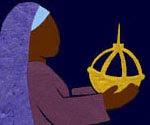And that same sociality which exists among us here will exist among us there, only it will be coupled with eternal glory, which glory we do not now enjoy.This statement, which predates D&C 132 by a few months, suggests that social bonds in general persist into the next world. And indeed, this makes perfect sense in light of LDS teachings elsewhere—going back to the Book of Mormon—which indicate that the resurrection means being restored to the bodies, knowledge, spiritual qualities, and personalities we have in mortality.
I take this to mean, then, that if a day indeed comes after death when my partner and I are restored to our physical bodies, we will again enjoy between ourselves the same sociality there that we enjoy here. We will still be in love, we will still feel passion for one another, and affection, and emotional attachment; we will still desire to be together—assuming, that is, that we still have that desire when the time comes for us to depart this world.
But now we come to D&C 132. And now we're being told that, actually, the same sociality that exists among us won't exist among us there unless our relationships, covenants, contracts, bonds, oaths, vows, connections, associations, expectations, etc. (v. 7) receive the proper ritual stamp of approval. Now we're presented with a vision of an afterlife in which two people who desire to be together for all eternity—who have made a covenant with one another to that effect (v. 18)—but whose relationship doesn't have the right words said over it by the right person will be separated so that they "remain separately and singly . . . to all eternity," as "servants . . . for those are worthy of a far [greater] . . . weight of glory" (vv. 16-17). In other words, D&C 132:15-18 gives us a vision of the afterlife that looks something along these lines:

One of the basic principles of my liberal scriptural hermeneutic is that generous readings trump stingy ones, given the premise that our Heavenly Parents are not people who give their children stones when they ask for bread (Matt. 7:9-11). D&C 132:15-18 speaks of a God who gives his children stones, or worse. D&C 130:2 points to a God who gives his children bread—better yet, who gives his children cake. If it is true, as some of Joseph Smith's other revelations suggest, that in the world to come our Heavenly Parents have prepared multiple kingdoms of glory because they are willing to let us have there whatever joy we chose here, then I can look forward in confidence to spending eternity with my chosen partner, assuming we both still want that and are still faithful to the covenant we have made to one another.
On June 9, 2001—Gay Pride weekend in Utah—my partner and I held a commitment ceremony. The ceremony was performed by a Unitarian minister, but we wrote it ourselves. It was structured after an LDS sealing ceremony, though we adapted it quite freely to express our theological understanding. In this ceremony, we made a covenant with one another in the presence of witnesses, and we laid before God the desires of our hearts. If relationships endure after death, we wanted that blessing for our relationship. If sexual partnerships can be holy, we wanted ours to be holy. We wanted our couplehood to be recognized, nurtured, supported, and honored as heterosexual couples are. In Genesis, Jacob wrestles with God to obtain a blessing. Similarly, my partner and I had blessings we wanted to obtain, and we've had to fight church and society to get them. Those wrestling matches still aren't over.
This is what we promised to one another:
M., do you take N. by the right hand, and give yourself to be joined to him in the eyes of God, and receive him to be joined to you in the eyes of God, desiring to remain with him for time and all eternity, with a covenant and promise that you will observe and keep all the responsibilities and obligations pertaining to a holy partnership, and this you do in the presence of God, angels, and these witnesses of your own free will and choice?And these are the blessings we sought—the blessings we asked the minister to invoke on our behalf:
I call down upon you blessings of peace, companionship, strength, energy, passion, health, protection, growth, fulfillment, pleasure, creativity, power, and abundance of life, with all the blessings of Abraham and Sarah, Isaac and Rebekah, Jacob and Rachel, and say to you: be fruitful and fill the measure of your creation, that you may have joy and rejoicing therein.
All these blessings, together with all the blessings which God desires to pour upon your partnership, I invoke upon you, through your faithfulness, in the name of God—Creator, Redeemer, and Comforter. Amen.


1 comment:
The large range of diamond thomas sabo jewellery often makes it very difficult for men to decide thomas sabo what type of thomas sabo ireland to purchase for their loved ones. Diamonds symbolize love, thomas sabo charms and thomas sabo bracelet , which makes it hard to choose the right piece of jewellry from the large variety of Diamond rings, Diamond earrings, Diamond thomas sabo pendants, Diamond thomas sabo necklaces, Diamond bracelets and of course Loose diamonds- which are always perfect since they can be set in any type of silver jewellery . We can’t choose the perfect diamond thomas jewellery for you but we can help you with 5 easy steps:Step 1- Knowing what she likes:Narrow down the type of sterling silver charms she likes to wear by observing the jewelry she wears in general, and on different occasions.The thomas jewellery she wears may vary.For example, her daytime jewelry may be different from the silver bracelets she wears when she goes out or to formal occasions.Knowing the color and size of the jewelry she wears:
Post a Comment